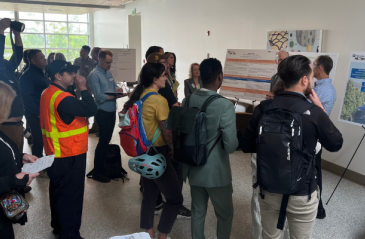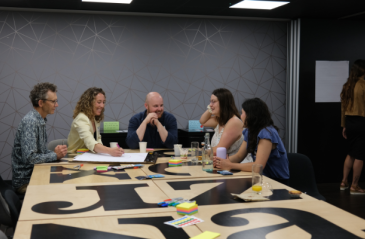
The information barriers holding back climate action and how to break them

Paul Romer: 'Focusing on investment as the key to growth is exactly where we should be looking'
Share articlePaul Romer: 'Investment – especially infrastructure investment – has very high returns'
Share articlePaul Romer: 'You can't have growth in income unless you have growth in human capital'
Share articleWe put our vision for government into practice through learning partner projects that align with our values and help reimagine government so that it works for everyone.
Serving as chief economist at the World Bank Group (WBG) is a highly prestigious position, but it's still somewhat surprising that Paul Romer has opted to pick up this particular baton.
After all, he is already established as an economist of global renown. He has also got many other commitments on his plate - university professor at NYU, director of the Marron Institute of Urban Management, and founding director of the Urbanization Project at the Leonard N. Stern School of Business to name but three. So, why would he want to join an organisation as vast and complex as the WBG? His answer is that the decision was made during a preliminary meeting with its president, Jim Kim.
"We started to talk about scale and how we want things to scale to billions," he recalls. "He immediately knew what I meant and leaned forward and became even more animated. We just connected, and that was when I concluded that the World Bank would be an exciting place to be."
Romer joins the WBG at an interesting time for the institution. Jim Kim was recently confirmed in post for a second four-year term and a number of internal organisational reforms are in the process of being bedded in. At its heart, though, the WBG remains what it always has been: a vital source of development knowledge, financial and technical assistance to low and middle income countries around the world
While its grand offices in the heart of Washington, DC certainly bespeak an organisation of considerable importance, the sheer scale of its global operations is worth repeating. Established in 1944, it has over 10,000 employees in more than 120 offices worldwide, all working towards its dual goals: ending extreme poverty by 2030, and promoting shared prosperity by fostering the income growth of the bottom 40% for every country. It is clear that Romer is relishing the opportunity to get amongst these highly-driven development professionals to help tackle the myriad challenges they face on a daily basis.
"I'm going to learn new things," he says. "For example, President Kim talked about the need to be intellectually prepared for pandemic emergency financing and the strategy on climate change. This fired off a whole bunch of different ideas about ways the Bank could pre-position policies and institutions for crises where we don't know the timing but we know they will happen. That's just one illustration of the stimulation I'm going to go through every week in this job."
Romer will also be deploying his expertise on economic growth - garnered from decades of study and publications - to the processes and programmes of the WBG. Indeed, Romer first came into the spotlight in the 1980s when there was much debate about why some countries achieved growth and others were less successful. Romer was a vocal advocate of "endogenous growth theory", arguing that investments in human capital, innovation and knowledge are significant contributors to growth. He remains a true believer, it transpires.
"It's important to pay careful attention to thinking about the actual word 'growth' and to think of the modifiers that go with it," he says. "There is the kind of growth that comes with fully utilising the capacity in an economy. There is a different kind of growth which is about increasing the total capacity for producing by having more skills among your workers and more physical capital." And why is investment so important? Romer believes it has multiple positive effects. "More investment will put resources to work and it can also create more capacity in the future," he says. "And so focusing on investment as the key to growth is exactly where we should be looking."
Unfortunately, achieving growth - a target uniting policymakers from governments large and small around the world - remains far easier to say than do, particularly in the years since the financial crisis. Romer believes that at this time of substantial headwinds and downgrades aplenty, it is vital to consider more than just the standard remedies. "We should look beyond using monetary policy or fiscal stimulus and instead look at the bottleneck which is holding back investment," he says. "Private firms, relative to their capacity and resources, are doing very little investment. It's quite possible that what we are facing here is a situation of higher uncertainty, and where there is uncertainty it is natural to keep your options open and not commit."
He also believes that governments need to analyse what it actually takes to initiate an investment project, especially the ones that are in such demand in the developing world - like infrastructure. "Investment - especially infrastructure investment - has very high returns," he points out. "It is cheap to do right now and we really have to push that forward."
Although Romer is still settling into his new role - he only started work in September - he is clear that helping the WBG position itself and its 189 member countries for future challenges will be a key priority. Take the looming impact of artificial intelligence and automation, for example. With technology poised to take over the jobs of millions of people in the years ahead, how will countries cope? Romer, for one, is staying calm.
"One of the things that come out of basic economic principles is that you can't have growth in income unless you have growth in human capital," he points out. “A lot of the acquisition of human capital comes on the job. Manufacturing has been the place where someone with very few skills can still be a valuable worker. It's possible this won't be the case in the future - entry-level manufacturing jobs might go away due to technology - so then what we have to look for are alternative employment opportunities for these people. I also spend enough time in Silicon Valley to be a little more sceptical about the claims that everything is changing over the next few years."
And as for helping the WBG's member countries chart a course towards future prosperity, he says that a lot of it comes down to better relationships and human interaction. "New technologies, AI and all of that are really valuable, but a lot of productivity growth can come from getting a group of people to work together more effectively, to cooperate, to clarify their communication with each other and resolve difficulties," he says. "This is as much of an issue in the start-up I ran, in the WBG itself, and in encouraging catch-up growth in Africa. So let's not forget the huge productivity gains that can come from getting people to work together more effectively."
This ability of people to overcome immense challenges helps explain the streak of optimism that is woven through Romer's DNA. "I have always been afraid they are going to take away my economist card because I am too optimistic," he admits. "I don't know whether we will achieve our goals of ending extreme poverty by 2030 and boosting shared prosperity, but the Bank has a real advantage because of the close proximity of the people who are publishing papers and doing the abstraction to the people who are making things happen on the ground. There is a healthy tension between the two, but I think it is more likely that we can do this inside the Bank than if I am hectoring my fellow academics. So I am very optimistic about what is possible."












